
95% of researchers rate our articles as excellent or good
Learn more about the work of our research integrity team to safeguard the quality of each article we publish.
Find out more
ORIGINAL RESEARCH article
Front. Ecol. Evol. , 10 February 2025
Sec. Population, Community, and Ecosystem Dynamics
Volume 13 - 2025 | https://doi.org/10.3389/fevo.2025.1437742
Intensive agriculture has caused significant declines in ground-dwelling arthropod diversity and ecosystem services. Chemical and organic fertilizers alter arthropod habitats, affecting arthropod community abundance and diversity. Fertilization treatments differentially affect arthropod communities, and various soil physico-chemical properties differentially affect various species in the arthropod community. Studying arthropod diversity, community structure, and soil physico-chemical properties under various fertilization treatments is crucial to understanding the impact of agricultural activities. We used pitfall traps to catch ground-dwelling arthropods four times a year, and analyzed arthropod abundance and biodiversity indices under different fertilization treatments The study revealed that Lycosidae and Araneidae were the dominant family in the study area. Notably, the application of both chemical and organic fertilizers led to a decrease in ground-dwelling arthropod diversity compared to unfertilized treatments. Furthermore, our analysis indicated that the strongest environmental predictors of ground-dwelling arthropod community variation varied depending on the fertilization method, and different species were affected differently by soil physico-chemical properties. Specifically, when no fertilization was applied, soil total potassium and available phosphorus were the strongest predictors of arthropod diversity. Conversely, organic matter became the primary determinant when organic fertilizers were used alone. Interestingly, when chemical and organic fertilizers were combined, soil total nitrogen, pH, and available phosphorus were identified as the principal drivers. Additionally, our findings highlighted that the dominant group of ground-dwelling arthropods was particularly sensitive to changes in biomass, available nitrogen, and available potassium.
The intensification of agriculture is one of the key factors in the decline of global biodiversity (Tscharntke et al., 2005; Bongaarts, 2019). In intensive agricultural production, there is often a high dependence on pesticides, fertilizers and other chemicals, incurring a high degree of environmental pollution risks in agricultural landscapes. Overuse of synthetic pesticides can negatively impact pollinators and other beneficial insects, resulting the reduction of their biodiversity and associated ecosystem services such as pollination and pest control (Janssen and van Rijn, 2021; Bian et al., 2022a; Marja et al., 2022). In recent years, the mechanization of agriculture and the overutilization of land resources have resulted in the large-scale reduction or even disappearance of semi-natural habitats in agricultural landscapes, and excessive dependence on high-yield monocropping has greatly reduced the heterogeneity of agricultural landscapes, therefore referred to as landscape simplification (Gabriel and Tscharntke, 2007; Lu et al., 2019; Nelson and Burchfield, 2021; Bian et al., 2022b; Marja et al., 2022). As a result, the ecosystem function of agricultural landscapes is damaged and the quality of ecosystem services are reduced, which seriously threatens the sustainability of agricultural production (Green et al., 2005; Lu et al., 2019).
Arthropods are the most diverse species in the animal kingdom and have been a major success in invertebrate evolution. They are an important component of ecosystems within terrestrial biomes (Edgecombe and Legg, 2014) and have a close relationship with human life. Arthropods are an important component of agroecosystems and are widely distributed in agricultural landscapes. Arthropod diversity shapes biotic communities in agroecosystems, holding potential to both negatively or positively impact crop health and yield (Knapp and Řezáč, 2017). Studies have shown that fertilizer treatments have a strong impact on arthropod communities. Organic fertilizer application often results in greater diversity of life stages of arthropods and increased diversity of carrion-feeding communities (Kong, 2018), while excessive application has been demonstrated to prolong arthropod larval development and reduce adult numbers (Boiteau et al., 2008). Synthetic fertilizer application has greater variability in its effects on arthropods, with some studies suggesting that soil organic matter and phosphorus content are the main drivers of changes in these communities (Gu et al., 2011), while others suggest that soil effective nitrogen and carbon to nitrogen ratios have a greater impact (Evans and Sanderson, 2018). A study showed that organic carbon and total nitrogen in paddy soils were the main drivers of arthropod density (Cao et al., 2022). Numerous studies have shown that the combined application of chemical and organic fertilizers increases arthropod diversity and richness and provides greater community stability in relation to the application of chemical fertilizers alone (Wu et al., 2019; Zhang, 2019). In reality, the mechanical and chemical perturbations of intensive agriculture have pushed fertilizer application on farmland beyond the threshold for positive effects on arthropods, negatively affecting the stability of arthropod community structure (Bedano et al., 2005; Kong, 2018). Some studies have also shown that fertilization treatments have no significant effect on spider population size (Zhang, 2013). At present, the changes in composition and diversity of ground-dwelling arthropod communities and the ecological mechanisms driving these due to fertilization treatments are not clear (Garratt et al., 2011; Meyer et al., 2019; Jacquot et al., 2019).
In this study, we aimed to investigate the effects of various fertilization treatments on ground-dwelling arthropod community structure and diversity in response to environmental changes. The study provides vital data to incorporate into biodiversity conservation decisions in agricultural landscapes and will help enhancing ecosystem service quality in the Huang-Huai-Hai Plain region. It also helps inform the sustainable development of agriculture.
The Huang-Huai-Hai Plain is an important agricultural economic zone and main grain producing area in China. The study area is established at the Ecological Experimental Station of Henan University, situated in Shuidao Township (114°18′12″E, 34°52′06″N), Kaifeng City, Henan Province (Figure 1), which locates in a typical area of the Huang-Huai-Hai Plain. The region has a warm-temperate continental monsoon climate. The mean annual temperature is 14.4°C. Precipitation is mostly concentrated in the summer, with a mean annual precipitation of 668.3 mm. The mean annual number of sunshine hours is 2107.8 h. The soil matrices and types in the study area are mainly Yellow River silt and sandy loam. Because of its flat terrain and four distinct seasons, this region is suitable for crop cultivation, and the staple crops are wheat and corn.
To compare different fertilizer treatments, we established 12 sample plots, each 3 m × 5 m in size and fenced with PVC boards. There was a 0.5 m buffer strip between all plots with drainage ditches to minimize waterlogging, fertilizer leaching, and lateral transfer of fertilizer during extreme precipitation events. No crops are planted around the sample plots.
The planting pattern was based on a winter wheat-summer maize biannual crop rotation system, and the planting varieties were referenced to the Fengqiu Agro-ecological Experimental Station of the Chinese Academy of Sciences. The wheat variety was Dwarf Resistance 58, and the maize variety was Zhengdan 958.
Fertilizer treatments were assigned in a randomized block design, where four fertilizer treatments were selected, with three replicates for each treatment. Fertilizer treatments were selected in consultation with local agricultural technology instructors, and included compound fertilizers with N:P:K of 15:15:15 and commercial organic fungal fertilizers formed by fermentation of soybean meal and bran. The four groups of fertilizer treatments were as follows: (1) No fertilizers (CK), (2) application of chemical fertilizers only (NPK), (3) application of organic fertilizers only (OM), and (4) combined application of chemical fertilizers with organic fertilizers (OMNPK). In the NPK and OMNPK treatments, the compound fertilizer was applied as a base fertilizer at 750 kg/ha before sowing at the end of September in the wheat season, and was applied as a follow-up fertilizer at 750 kg/ha in March of the following year. In the maize season, before sowing in early June, compound fertilizer was applied as a base fertilizer at a rate of 750 kg/ha. In the OM and OMNPK treatments, organic fertilizer was applied throughout the year totaling 3600 kg/ha (the conventional rate).
According to previous literature on biodiversity survey of ground-dwelling arthropod in different regions (Fahrig et al., 2015; Ng et al., 2018; Martin et al., 2020; Bian et al., 2022a, b), we conducted surveys four times in 2022: 1) the wheat growing season in March, 2) the wheat maturing season in May, 3) the maize growing season in July, and 4) the maize maturing season in September. These surveys were conducted using the pitfall trap method. Traps were set up at three randomly selected sampling sites in each sample plot, spaced at least 2 meters apart. Polypropylene plastic cups with a diameter of 7.8 cm, bottom diameter of 6 cm, and depth of 12.5 cm were buried in the soil. The mouth of the cups was set flush with the surface and a rain shield containing saturated saline and detergent was set 5 cm above them. The traps were left in the field for 5 days and then retrieved. The macrofauna were sorted out of traps in situ by hand after mixing the three samples from the same plot. The collected arthropods were stored in 10 mL centrifuge tubes with lids containing 95% alcohol, numbered, and transported to the laboratory for species-level identification according to taxonomic literature.
Soil samples were collected at the same time as the ground-dwelling arthropods. Soil samples were collected from three randomly selected sample points in each sample area, and after removing surface debris, a 3.5 cm diameter soil auger was used to auger 0-10 cm and 10-20 cm of surface soil. The three 0-10 cm and 10-20 cm soil samples were mixed well and passed through a 2 mm soil sieve. They were then brought back to the laboratory in sealed bags. 100 g of each soil sample was taken to determine the moisture content of the soil, and the remaining part of each soil sample was placed in a cool and ventilated place to dry naturally and then sieved for the determination of soil physico-chemical properties.
Densities were calculated based on the number of ground-dwelling arthropod individuals captured. Species with relative densities above 10% were considered dominant family, those with relative densities between 1% and 10% were considered common, and those with relative densities less than 1% were considered rare. Species diversity indices were computed using the Shannon-Wiener Diversity Index, the Simpson Index of Dominance, the Margalef Index of Richness, and Pielou’s evenness index (Simpson, 1995). Diversity indices were calculated using Jaccard’s similarity index, Sørensen’s index, and Simpson’s similarity index.
α species diversity index:
S is the number of taxa of soil animals; N is the total number of individuals of all species in the community; Pi is the proportion of the number of individuals of Class i soil animals to the total number of individuals.
β species diversity index:
a is the number of species unique to the first quadrat, b is the number of species unique to the second quadrat, and c is the number of species common to both quadrats.
The captured ground-dwelling arthropods were classified into four groups by their feeding habits: predatory arthropods, herbivorous arthropods, saprophytic arthropods, and omnivorous arthropods, based on soil fauna feeding (Liu, 2019).
The statistical analysis methods used in this study included principal coordinates analysis (pCoA), multivariate ANOVA, the Mentel test, and Pearson correlation analysis. Among them, pCoA was used to study the differences in species composition of ground-dwelling arthropod communities among different fertilizer treatments; Multivariate ANOVA was used to study the effects of fertilizer and pesticide interference mode, time, and their interaction on ground-dwelling arthropod diversity indices and soil physico-chemical properties, and the significance of the differences was tested by LSD Duncan and Kruskal-Wallis rank-sum tests; and Mentel test was used. The key soil physico-chemical properties affecting ground-dwelling arthropods were screened out, and the relationship between species composition and diversity index of ground-dwelling arthropods and soil physico-chemical properties was investigated by Pearson correlation analysis. All calculations were performed using R (Version 4.3.2, www.r-project.org).
A total of 523 ground-dwelling arthropods belonging to 9 orders and 34 families were captured in the CK sample. Among them, Lycosidae (16.25%) and Linyphiidae (14.72%) were the dominant family. According to their feeding habits, predatory arthropods accounted for the highest proportion with 49.71%, followed by omnivorous arthropods with 28.30%, saprophytic arthropods with 13.77%, and herbivorous arthropods with the lowest proportion of 8.22%.
A total of 312 ground-dwelling arthropods belonging to 8 orders and 25 families were captured in the NPK sample. Among them, Lycosidae (19.87%) was the dominant taxon. According to their feeding habits, predatory arthropods accounted for 54.17%, omnivorous arthropods 33.33%, herbivorous arthropods 6.41%, and saprophytic arthropods had the lowest percentage of 6.09%.
A total of 475 ground-dwelling arthropods belonging to 8 orders and 34 families were captured in the OM sample. Among them, Lycosidae (15.79%) and Linyphiidae (14.11%) were the dominant family. According to their diet, 47.37% were predatory arthropods, 28.84% were omnivorous arthropods, 14.74% were herbivorous arthropods, and 9.05% were saprophytic arthropods.
A total of 1,672 ground-dwelling arthropods were captured in the OMNPK quadrats, belonging to 10 orders and 41 families. Among them, Lycosidae (16.93%), Araneidae (10.83%) and Carabidae (8.25%) are the dominant family. According to their food habits, predatory arthropods account for 49.88%, omnivorous arthropods account for 30.44%, saprophytic arthropods account for 10.29%, and herbivorous arthropods account for 9.39% (Figure 2A).
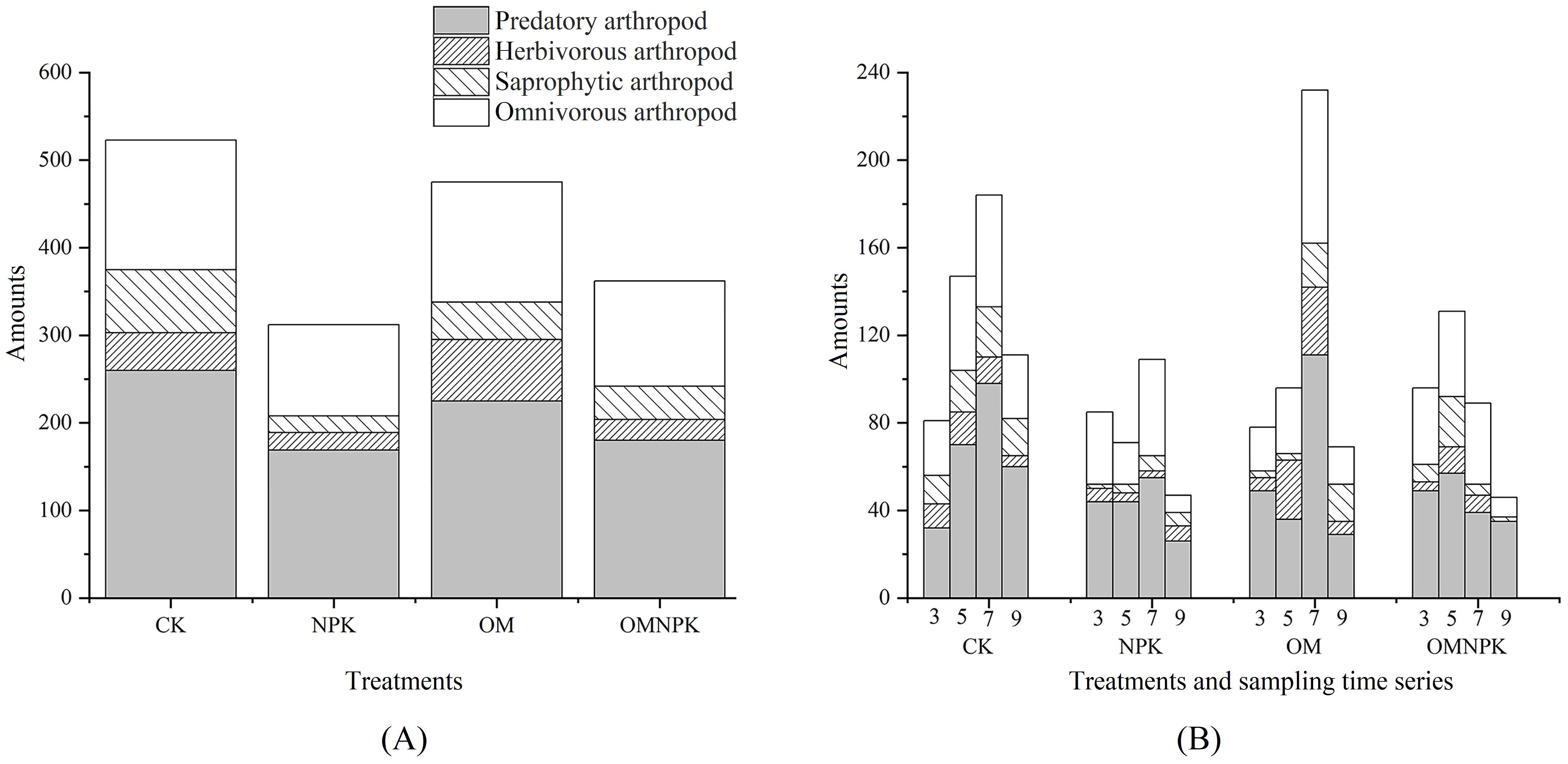
Figure 2. Ground-dwelling arthropod species composition and its polytope variation. (A) ground-dwelling species composition throughout the year under different fertilizer treatments (B) Changes in ground-dwelling arthropod number at different sampling times.
Ground-dwelling arthropod abundance varied by sampling time: Under the CK treatment, ground-dwelling arthropod abundance was highest in July, followed by May, September, and March; under the NPK treatment, ground-dwelling arthropod abundance was highest in July, followed by March and May, and lowest in September; and under the OM treatment, ground-dwelling arthropod abundance was also highest in July, followed by May, March, and September; Under the OMNPK application, ground-dwelling arthropod abundance was highest in May, followed by March and July, and ground-dwelling arthropod abundance was lowest in September.
Averaged across all four sampling periods, the largest functional group of ground-dwelling arthropods was predatory arthropods, followed by omnivorous arthropods, saprophytic arthropods, and lastly, herbivorous arthropods. Across all sampling times, predatory arthropods were the most common functional group, followed by omnivores. In March and September, herbivorous arthropods were the third most abundant, followed lastly by saprophytic arthropods; however, in July, these two functional groups switch in dominance rank, and in May, they were roughly comparable (Figure 2B).
We calculated diversity indices of ground-dwelling arthropods for the whole year under different fertilization treatments, and concluded that the Shannon-Wiener diversity index was significantly higher under the CK treatment than the NPK treatment, and the Shannon-Wiener diversity index was significantly higher under the OMNPK treatment than that of the OM treatment. The Simpson diversity index, the Margalef richness index, and the number of species were significantly higher under CK and OM treatments than NPK treatment (Figure 3). There was a significant effect of NPK treatment on the Shannon-Wiener diversity index, Simpson diversity index, Margalef richness index, and number of species family (p<0.01), while the effect of OM treatment and OMNPK on the diversity indices of the ground ground-dwelling arthropod community was not significant.
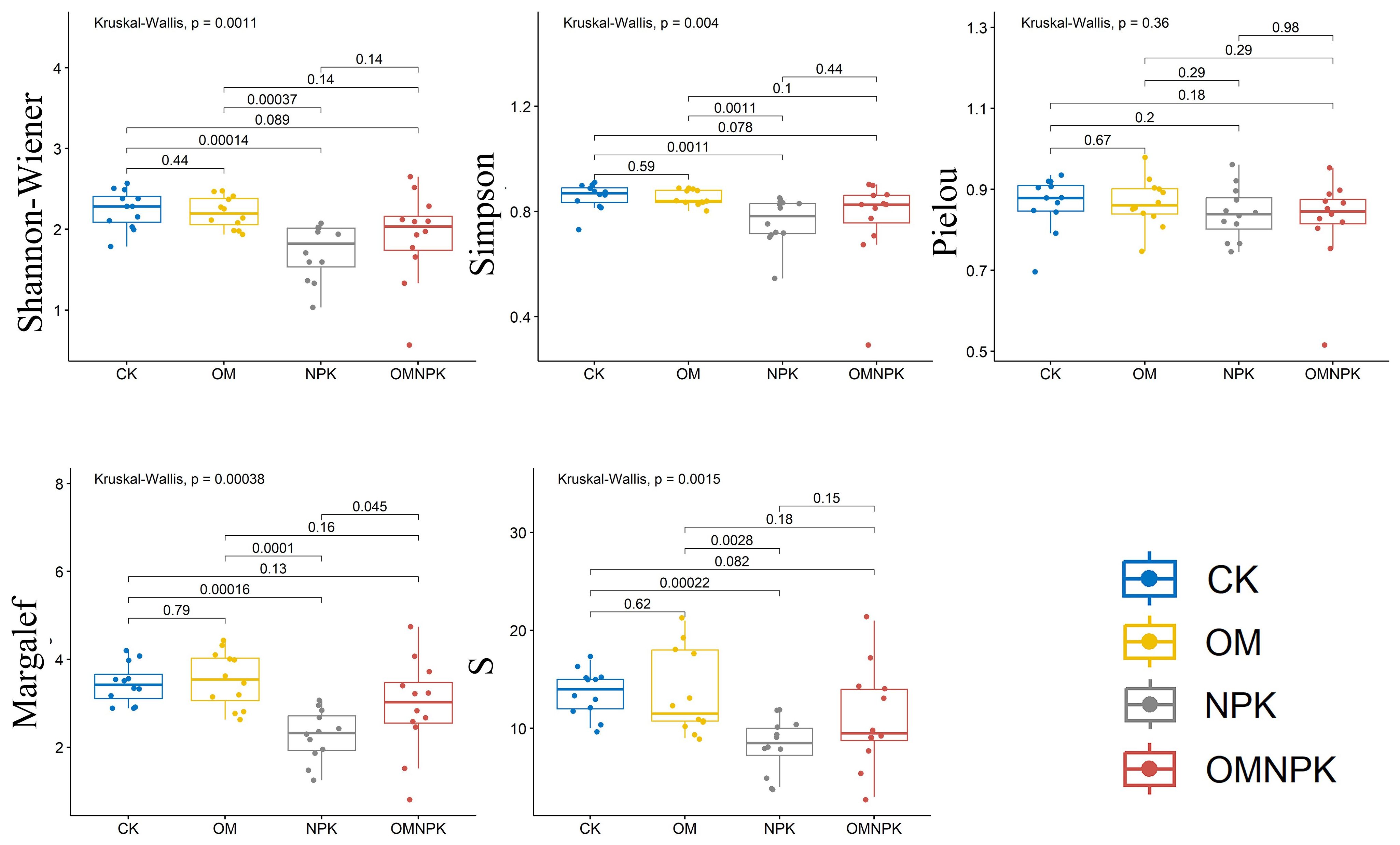
Figure 3. Diversity indices of ground-dwelling arthropods under different fertilization treatments throughout the year.
Calculation of ground-dwelling arthropod diversity indices from four sampling sessions under different fertilizer treatments showed that Shannon-Wiener diversity indices were significantly (p<0.05) higher in March than in July and September under the CK and NPK treatments, and significantly (p<0.05) higher in May than in September under the OMNPK treatment. Simpson diversity index was significantly higher (p< 0.05) in March and May than in September under CK treatment and in March than in September under OMNPK treatment. Pielou evenness index was significantly higher (p< 0.05) in May than in July under NPK treatment. Margalef richness index was significantly higher (p< 0.05) in March than in July and September under CK treatment and in May than in September under OMNPK treatment. The number of species family was significantly higher (p<0.05) in July than in September under the OM treatment, and significantly higher (p<0.05) in May than in September under the OMNPK treatment (Figure 4). In conclusion, the ground-dwelling arthropod diversity index was significantly higher in the wheat season than in the maize season.

Figure 4. Ground-dwelling arthropod diversity index under different sampling time and fertilization treatments. Letters indicate significant (p>0.05) differences between groups. Capital letters A, B and C represent ANOVA results of different treatments in the same month, lowercase letters a and b represent ANOVA results of different months under the same treatment.
Multifactorial analysis of variance (ANOVA) of different fertilizer treatments, soil physico-chemical properties and crop biomass showed that there was a significant effect of NPK on soil total nitrogen, total potassium, and crop root biomass (p<0.05). There was also a highly significant effect of NPK on soil pH, total phosphorus, total potassium, plant-available phosphorus, total carbon, crop spike biomass and culm biomass (p<0.01). There was a highly significant effect of OM on soil total carbon (p<0.01) and significant effect (p<0.05) of OMNPK on soil total carbon (Table 1).
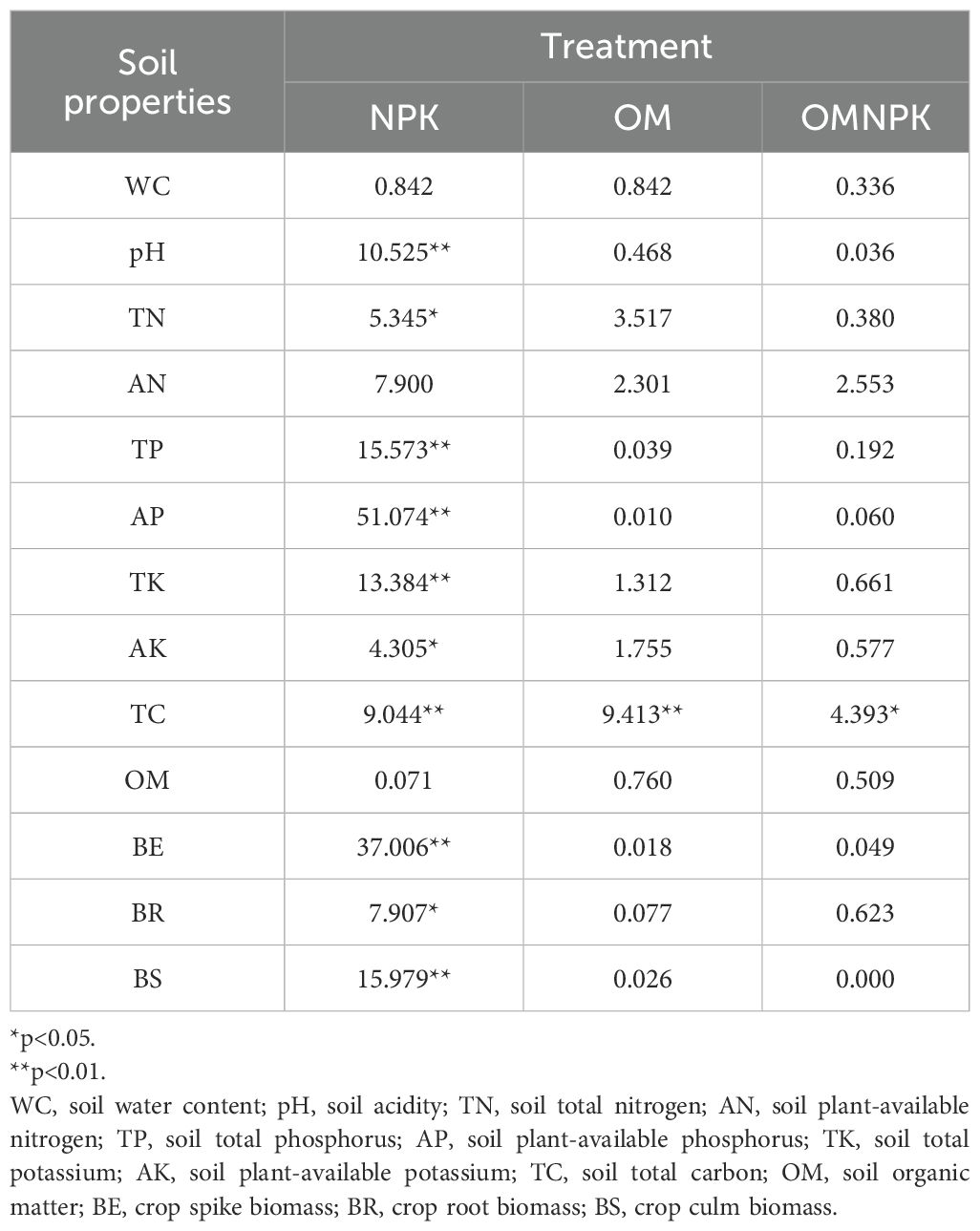
Table 1. Results of multifactorial analysis of variance (ANOVA) for different fertilizer treatments, soil physico-chemical properties and crop biomass.
The application of organic fertilizer can improve the physical properties of soil, which is manifested in the promotion of plant growth and the return of litter, as well as the enhancement of soil aggregates stability and nutrient retention ability. Chemical fertilizer can also increase nutrient levels in the soil. However, when the application amount exceeds a certain threshold, it may lead to soil acidification, salinization and other phenomena, which can negatively influence plant growth and soil animal biodiversity.
The results of the correlation analysis between ground-dwelling arthropod diversity and soil physico-chemical properties in CK treatment (Figure 5) showed that Margalef richness index of all species was negatively correlated with crop root biomass (p<0.01), and Pielou evenness index was positively correlated with soil total potassium (p<0.01). The Shannon-Wiener diversity index was positively correlated with soil phosphorus, negatively correlated with spike biomass, negatively correlated with crop culm biomass, and negatively correlated with soil phosphorus. The Simpson diversity index was positively correlated with soil phosphorus, and negatively correlated with crop culm biomass and soil phosphorus. Simpson’s diversity index was positively correlated with soil total potassium and plant-available phosphorus.
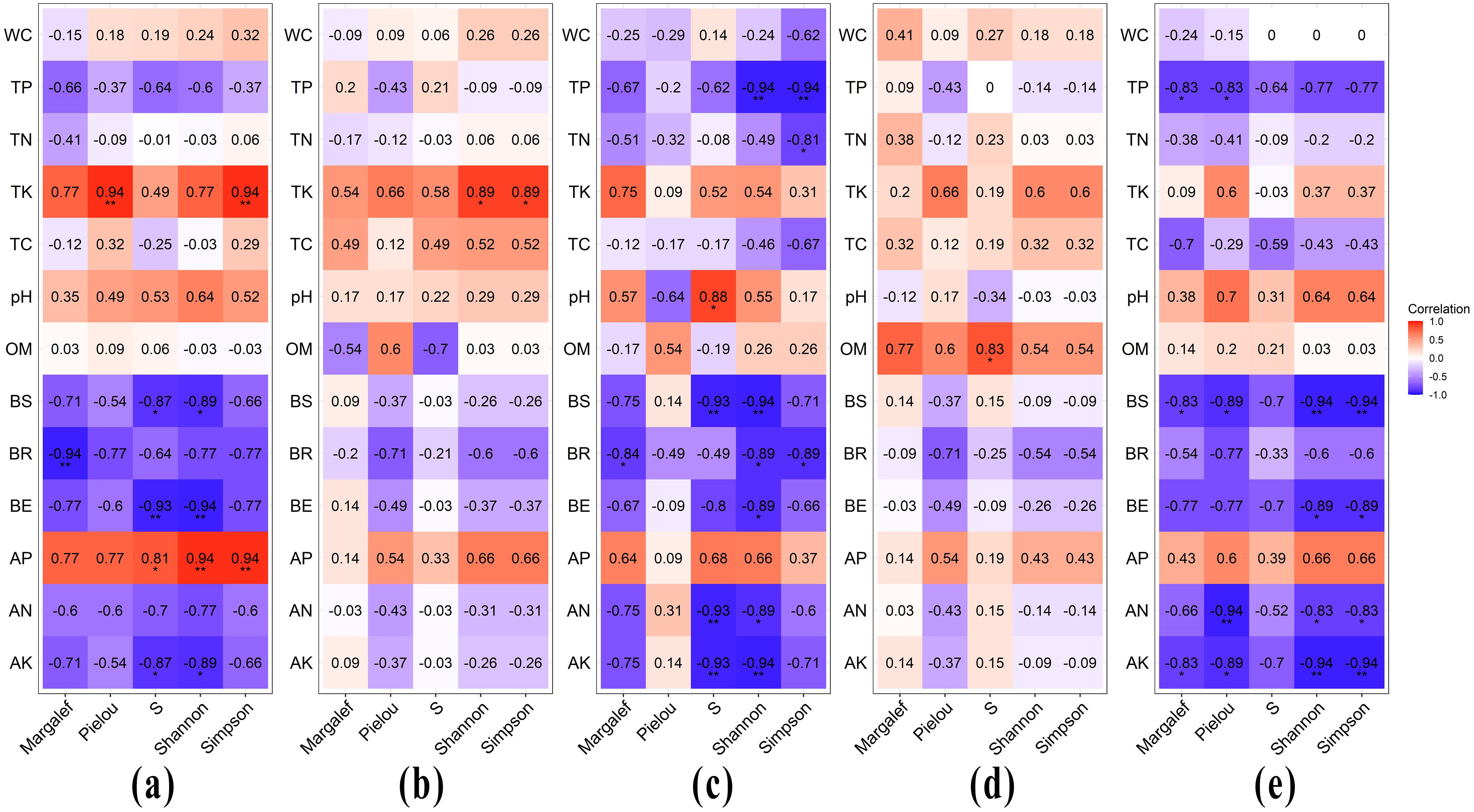
Figure 5. Correlation analysis between ground-dwelling arthropod diversity and soil physico-chemical properties under no fertilizer treatment. (A) All communities (B) Predatory (C) Herbivorous (D) Saprophytic (E) Omnivorous.
Both Shannon-Wiener diversity index and Simpson diversity index of predatory arthropods were significantly and positively correlated with soil total potassium. The Margalef richness index of herbivorous arthropods was significantly negatively correlated with crop root biomass, and the number of species groups was significantly positively correlated with soil pH, and negatively correlated with crop culm biomass (p<0.01), plant-available nitrogen, and plant-available potassium. The Shannon-Wiener diversity index was significantly negatively correlated with plant-available nitrogen, crop root biomass, and spike biomass, and negatively correlated with total phosphorus (p<0.01), plant-available potassium, and crop culm biomass. Simpson’s diversity index was significantly negatively correlated with total phosphorus, and significantly negatively correlated with total nitrogen and crop root biomass. For saprophytic arthropods, the number of species was significantly and positively correlated with organic matter content. For omnivorous arthropods, Margalef’s richness index was significantly negatively correlated with total phosphorus, plant-available potassium, and crop culm biomass. Pielou’s evenness index was significantly negatively correlated with total phosphorus, plant-available potassium, and crop culm biomass, and highly significant negatively correlated with plant-available nitrogen; Shannon-Wiener’s and Simpson’s diversity indices were negatively correlated with crop culm biomass and plant-available potassium (p<0.01), and highly significant negatively correlated with crop root biomass and plant-available potassium; and the number of species was significantly correlated with organic matter content. Shannon-Wiener diversity index and Simpson diversity index were significantly negatively correlated with crop culm biomass and plant-available potassium, and with crop spike biomass and plant-available nitrogen.
The results of correlation analysis between ground-dwelling arthropod diversity and soil physico-chemical properties under OM treatments showed (Figure 6) that Margalef richness index of all species was positively correlated with soil organic matter (p<0.01) and negatively correlated with soil total nitrogen (p<0.05). Shannon-Wiener diversity index was negatively correlated with soil total nitrogen (p<0.05) and positively correlated with soil organic matter (p<0.01). Simpson Diversity index was positively correlated with soil organic matter (p<0.01).
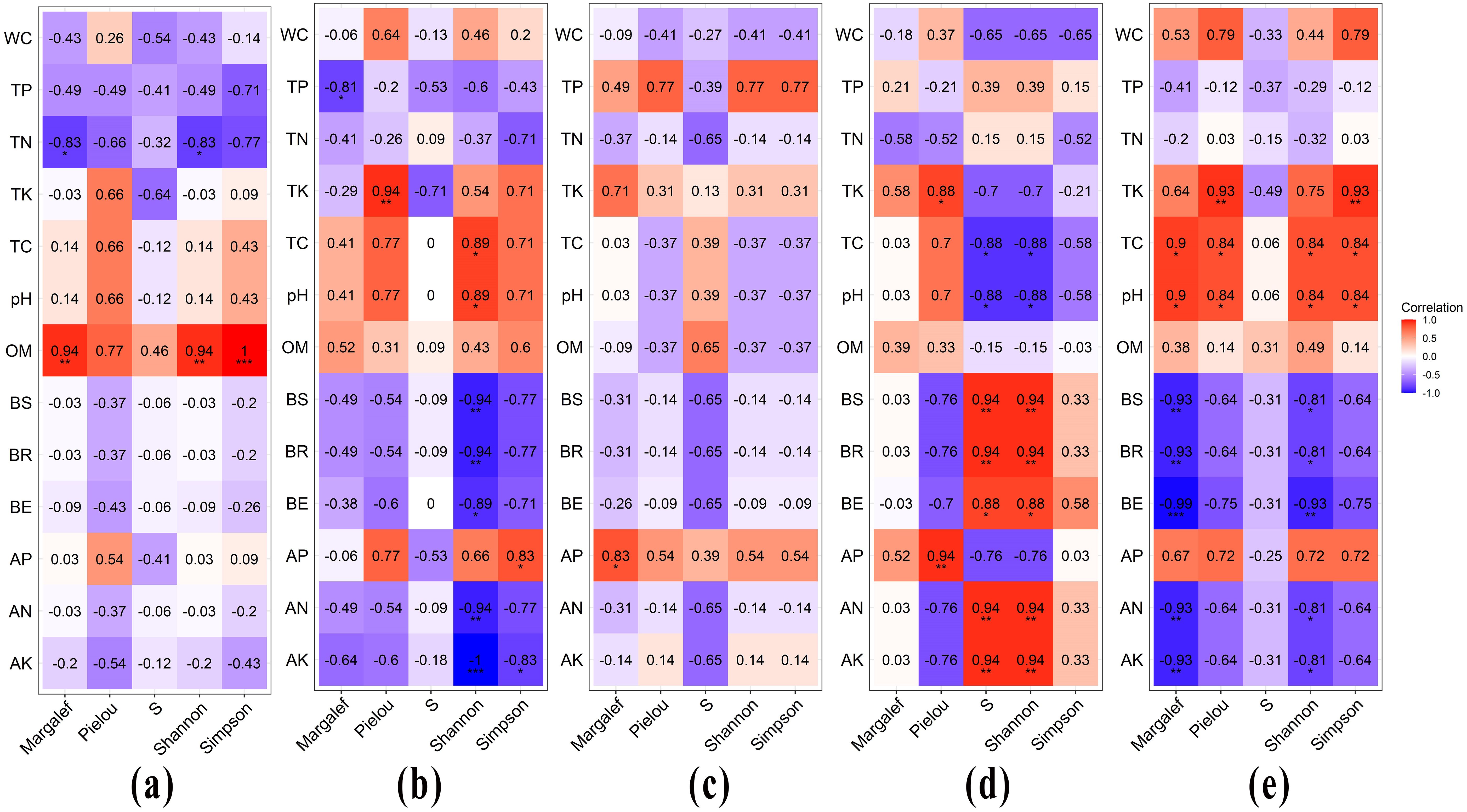
Figure 6. Correlation analysis between ground-dwelling arthropod diversity and soil physico-chemical properties under organic fertilizer treatment. (A) All communities (B) Predatory (C) Herbivorous (D) Saprophytic (E) Omnivorous.
The Margalef richness index of predatory arthropods was significantly negatively correlated with soil total phosphorus, the Pielou evenness index was positively correlated with soil total potassium (p<0.01), the Shannon-Wiener diversity index was significantly positively correlated with soil total carbon and soil pH, significantly negatively correlated with crop spike biomass, and negatively correlated with crop culm biomass, root biomass, plant-available nitrogen and plant-available potassium (p<0.01). Simpson’s diversity index was positively correlated with plant-available phosphorus and negatively correlated with plant-available potassium. The Margalef richness index of herbivorous arthropods was positively correlated with soil plant-available phosphorus. The Pielou evenness index of saprophytic arthropods was significantly and positively correlated with soil total potassium, and positively correlated with plant-available phosphorus (p<0.01). The number of species and the Shannon-Wiener diversity index were significantly and positively correlated with crop root biomass, and positively correlated with crop culm biomass and spike biomass, and soil plant-available nitrogen and plant-available potassium (p<0.01), and highly and significantly and negatively correlated with soil pH and total carbon. The Margalef richness index of omnivorous arthropods was significantly positively correlated with total carbon and soil pH, and negatively correlated with crop root biomass, pole biomass, spike biomass, plant-available nitrogen, plant-available potassium (p<0.01). The Pielou evenness index was significantly positively correlated with total carbon and soil pH, and positively correlated with soil total potassium (p<0.01), and the Shannon-Wiener diversity index was significantly positively correlated with total carbon, soil pH was significantly positively correlated with crop root biomass, culm biomass, plant-available nitrogen, plant-available potassium, and highly significant negative correlation with crop spike biomass, and Simpson’s diversity index was positively correlated with soil whole potassium, and positively correlated with soil whole carbon and soil pH (p<0.01).
The correlation between ground-dwelling arthropod diversity and soil physico-chemical properties were weak under the NPK treatment (Figure 7). The number of predatory arthropod species was significantly negatively correlated with soil plant-available potassium. The number of herbivorous arthropod species was significantly negatively correlated with total nitrogen and soil pH, and the Shannon-Wiener diversity index was significantly negatively correlated with soil pH. Due to the low number of saprophytic arthropods collected under the fertilizer-only treatment, a correlation analysis could not be conducted on this subgroup.
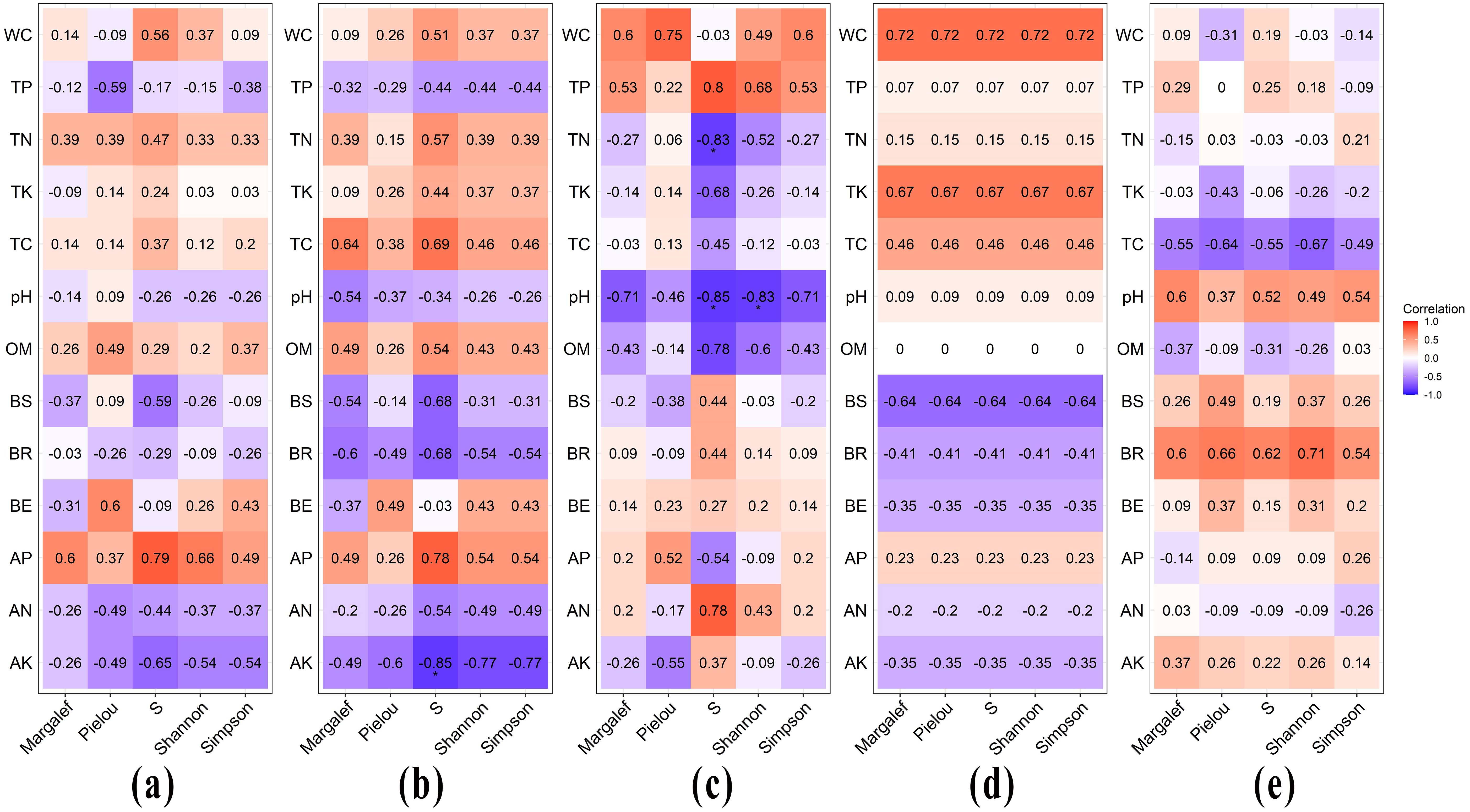
Figure 7. Correlation analysis between ground-dwelling arthropod diversity and soil physico-chemical properties under fertilizer-only treatment. (A) All communities (B) Predatory (C) Her-bivorous (D) Saprophytic (E) Omnivorous.
The results of correlation analysis between ground-dwelling arthropod diversity and soil physico-chemical properties under the OMNPK treatment showed (Figure 8) that Margalef richness index, Pielou evenness index, Shannon-Wiener diversity index and Simpson diversity index of all species were positively correlated (p<0.01) with total soil nitrogen, in addition to the significant positive correlation between Simpson diversity index. Soil pH was also significantly positively correlated with ground-dwelling arthropod diversity, and the number of species was significantly positively correlated with total nitrogen and plant-available phosphorus, and significantly negatively correlated with crop root biomass.
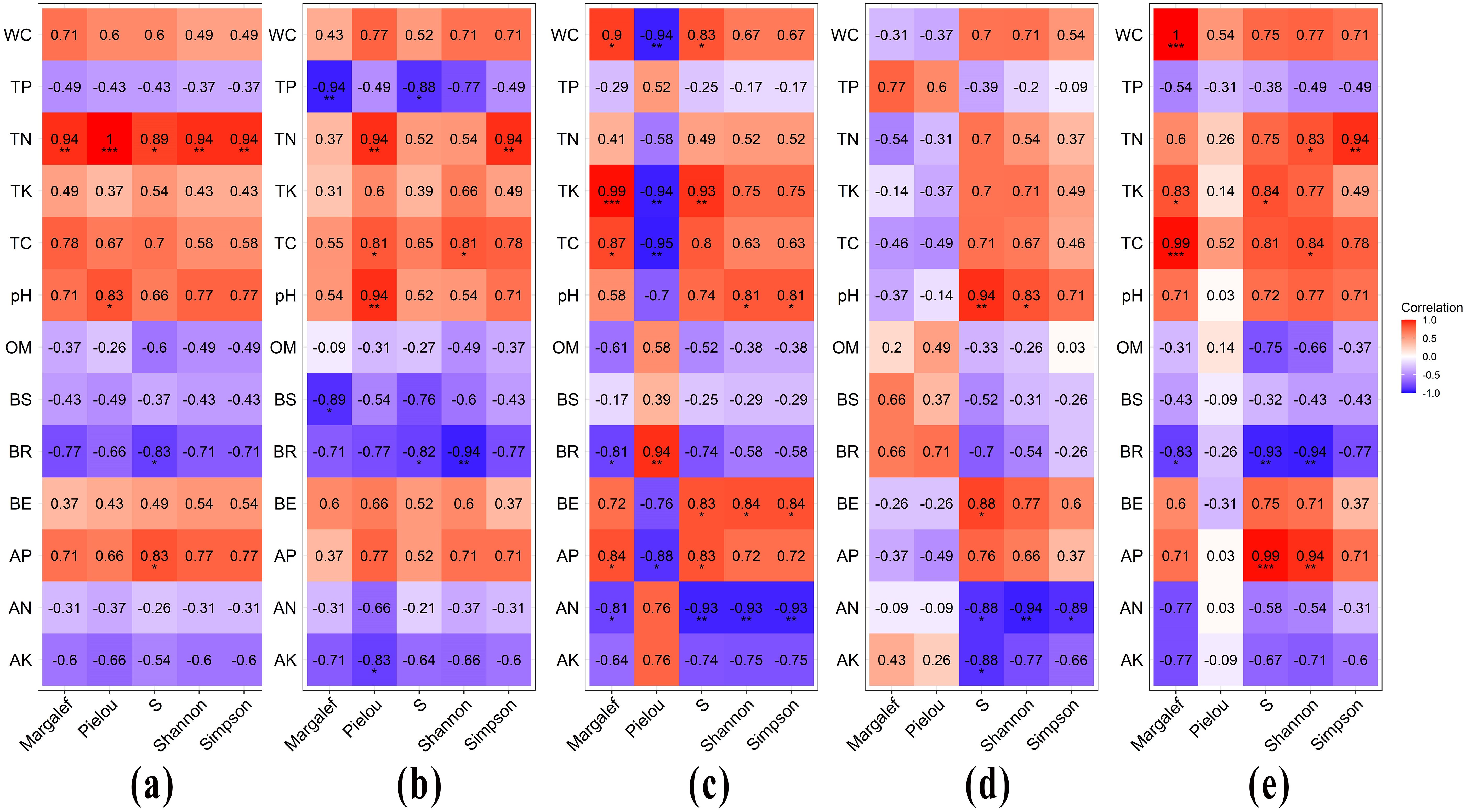
Figure 8. Correlation analysis between ground-dwelling arthropod diversity and soil physico-chemical properties under fertilizer and organic fertilizer co-application treatment. (A) All communities (B) Predatory (C) Phytophagous (D) Saprophytic (E) Omnivorous.
The Margalef richness index of predatory arthropods was significantly negatively correlated with crop culm biomass and negatively correlated with soil total phosphorus (p<0.01), the Pielou evenness index was significantly positively correlated with total carbon, positively correlated with total nitrogen and soil pH (p<0.01), and significantly negatively correlated with plant-available potassium. The number of species was significantly negatively correlated with total phosphorus and crop root biomass. The Shannon-Wiener diversity index was significantly positively correlated with total carbon, and was negatively correlated with crop root biomass (p<0.01), and the Simpson diversity index was significantly positively correlated with total nitrogen. The Wiener diversity index was significantly positively correlated with total carbon and negatively correlated with crop root biomass, and the Simpson diversity index was significantly positively correlated with total nitrogen. The Margalef richness index of herbivorous arthropods was significantly positively correlated with soil water content, total carbon and plant-available phosphorus, significantly positively correlated with soil total potassium, and significantly negatively correlated with crop root biomass and plant-available nitrogen, while the Pielou evenness index was significantly positively correlated with crop root biomass, as well as significantly negatively correlated with soil plant-available phosphorus, and significantly negatively correlated with soil water content, total potassium, and total carbon. The number of species was negatively correlated with crop root biomass. The Shannon-Wiener diversity index and Simpson diversity index were positively correlated with soil pH and crop spike biomass, and negatively correlated with plant-available phosphorus, and negatively correlated with total potassium and plant-available nitrogen. For saprophytic arthropods, the number of species and crop spike biomass had a significant positive correlation, while there was a highly significant negative correlation with soil pH, a significant negative correlation with plant-available nitrogen and plant-available potassium. There was also a significant positive correlation between the Shannon-Wiener diversity index and soil pH, a highly significant negative correlation with soil plant-available nitrogen, and a significant negative correlation between the Simpson diversity index and plant-available nitrogen. For omnivorous arthropods, the Margalef richness index was significantly positively correlated with soil total potassium, highly significant positively correlated with water content and total carbon, and significantly negatively correlated with crop root biomass, the number of species family was negatively correlated with crop root biomass, positively correlated with soil total potassium, and positively correlated with soil plant-available phosphorus (p<0.01), and Shannon-Wiener diversity index was significantly negatively correlated with total nitrogen and total carbon, and Simpson diversity index was significantly negatively correlated with plant-available nitrogen. The Shannon-Wiener diversity index was significantly positively correlated with total nitrogen and total carbon, significantly positively correlated with plant-available phosphorus, and significantly negatively correlated with crop root biomass, and the Simpson diversity index was significantly positively correlated with total soil nitrogen.
The abundance of ground-dwelling arthropod is the lowest under NPK treatment compared with other treatments, in agreement with previous research (Wang et al., 2016; Huang et al., 2023). The application of organic fertilizer has less impact on soil animal diversity, and could even increase the diversity by providing food sources and habitat coverage. However, the diversity of predatory, saprophytic and omnivorous were not increased in this study. This may be related to the application amount of organic fertilizer. The growth of intermediate host plants is good under OM treatment, and they provide space for phytophagous arthropod to survive, so the abundance of the phytophagous is the highest. Diversity of ground-dwelling arthropod under NPK treatment is less affected by the environment. It is highly likely that the application of NPK has a direct lethal effect on ground-dwelling arthropod, therefore, the influence of environmental factors was weakened.
To identify the soil physico-chemical properties that influence characteristics of the ground-dwelling arthropod community under different fertilization treatments, we performed a Mantel test correlation between the Bray-Curtis distance matrix for the ground-dwelling arthropod community and the Euclidean distance matrix for the soil physico-chemical parameters (Figure 9).
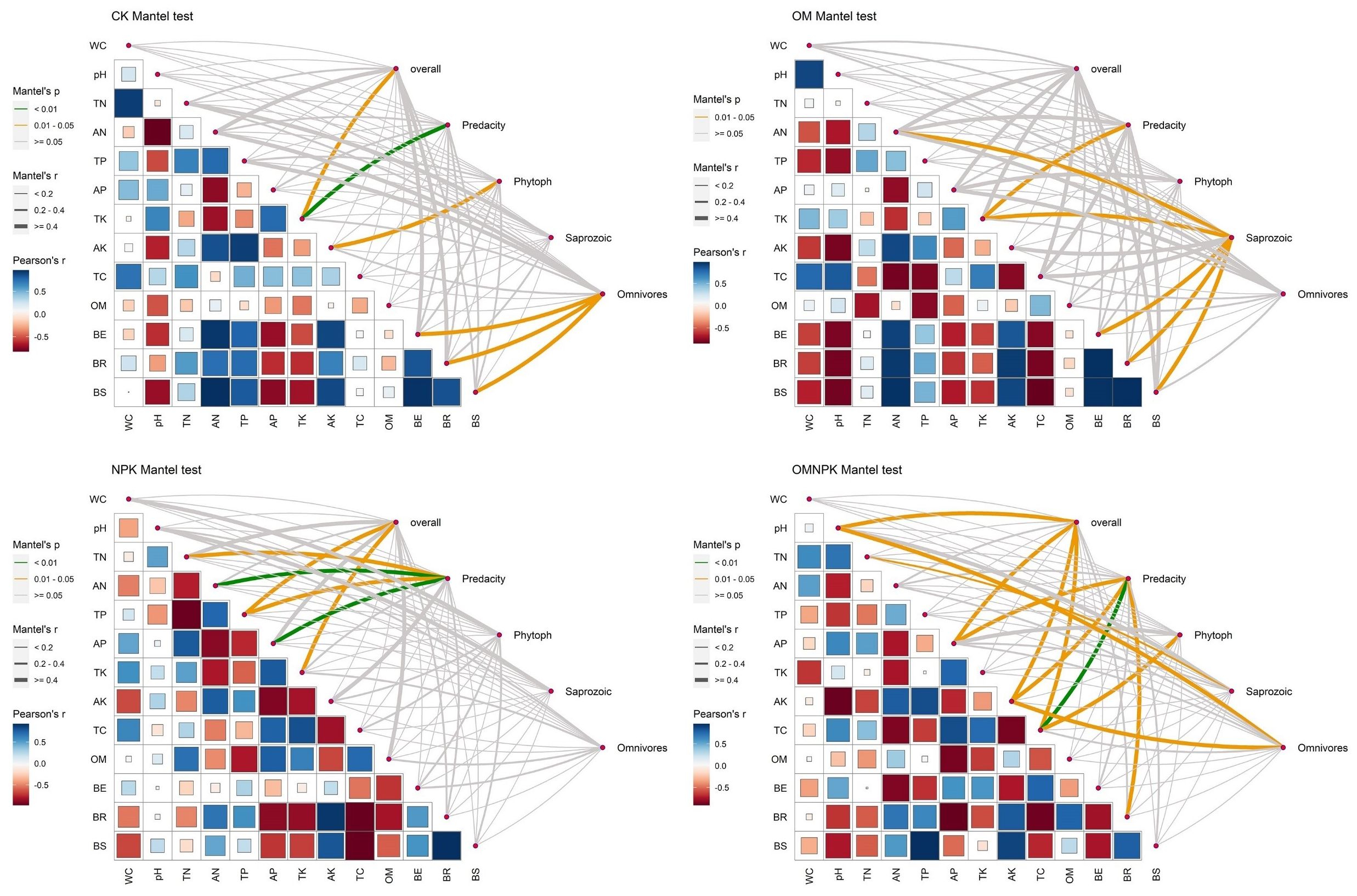
Figure 9. Correlation analysis between ground-dwelling arthropods and soil physico-chemical properties under different fertilization treatments.
In the control plots, soil total potassium significantly (p<0.05) affected the community composition of all species and highly significantly (p<0.01) affected the community composition of predatory arthropods, soil plant-available potassium significantly (p<0.05) affected the community composition of herbivorous arthropods, and crop spike biomass, root biomass, and culm biomass all significantly (p<0.05) affected the community composition of omnivorous arthropods (p<0.05). Community composition of predatory arthropods was significantly (p<0.05) affected by soil total potassium under OM treatment, and community composition of saprophytic arthropods was significantly (p<0.05) affected by soil plant-available nitrogen, total potassium, crop root biomass, culm biomass, and spike biomass. Overall community composition was significantly (p<0.05) affected by soil total phosphorus and soil total potassium under NPK treatment, while predatory arthropods were significantly (p<0.05) affected by soil total nitrogen and total phosphorus content, and highly significantly (p<0.01) affected by soil plant-available nitrogen and plant-available phosphorus content. Under OMNPK treatment, overall community composition was significantly (p<0.05) affected by soil pH, soil plant-available phosphorus, plant-available potassium, and total carbon content, and predatory arthropods were significantly affected by soil plant-available phosphorus, plant-available potassium, and crop root biomass (p<0.05); and highly significantly affected (p<0.01) by soil total carbon. Herbivorous arthropods were significantly (p<0.05) affected by soil total carbon, saprophytic arthropods were significantly (p<0.05) affected by soil total nitrogen, and omnivorous arthropods were significantly (p<0.05) affected by soil pH and plant-available potassium content.
This study systematically analyzed the impacts of diverse fertilization treatments on soil physico-chemical properties and the abundance and diversity of ground-dwelling arthropods, and subsequently delved into the relationships therein. The results evidently demonstrate that 1) both organic and chemical fertilizers are capable of significantly decreasing the abundance of ground-dwelling arthropods. However, with respect to the diversity, it was observed that when only organic fertilizer was applied, the diversity of herbivorous arthropods reached the highest level. 2) By comparing the results of the four surveys, it was found that the community composition of ground-dwelling arthropods changed significantly during the maize growing season in July. This was manifested in the highest abundance and diversity of ground-dwelling arthropods. 3) The responses of ground-dwelling arthropods to soil physico-chemical properties vary under different fertilization treatments. The diversity of ground-dwelling arthropods exhibited a weak correlation with the soil physico-chemical properties under the NPK treatment, yet a strong correlation was observed under the OMNPK treatment.
The study still has some limitations. Firstly, the experiment in this study was not replicated over multiple years. Although the data from a single year could explicate the scientific issues of our concern, it is essential to conduct a multi-year comparative study. Secondly, since the number of species of ground-dwelling arthropods that we collected is large and the identification was rather difficult, only families were identified in this study. If the species identification level could be improved in future studies, it would be helpful to refine the functional group of the ground-dwelling arthropods. Lastly, we only focused on different fertilization treatments in this study. However, there are many agricultural management practices that could impact ground-dwelling arthropods, such as the application of pesticides. Fully considering fertilization treatments, pesticide applications and other potential disturbances in follow-up studies will help to better understand the interaction mechanism between ground-dwelling arthropods and the improvement of the food production environment.
Ground-dwelling arthropods are sensitive to the variations of the surrounding environment in agricultural landscapes. The ground-dwelling arthropods focused on in this study are predominantly natural enemies. Against the backdrop of agricultural intensification and the biodiversity crisis, it is imperative to reinforce their protection. By appropriately applying fertilizers and creating a suitable living environment to increase the abundance and biodiversity of predatory arthropods in agricultural landscapes, the number of herbivorous arthropods can be decreased through integrated pest management, while simultaneously enhancing the stability of the ecological network. This holds great significance for biodiversity conservation, the provision of ecosystem services in agricultural landscapes, and the integrated pest management of terrestrial ecosystems.
The original contributions presented in the study are included in the article/supplementary material. Further inquiries can be directed to the corresponding author.
Ethical review and approval were not required for the study on animals in accordance with the local legislation and institutional requirements.
ZB: Data curation, Formal analysis, Investigation, Methodology, Writing – original draft. LL: Investigation, Data curation, Writing – original draft. YL: Investigation, Formal analysis, Methodology, Resources, Writing – original draft. YLL: Data curation, Investigation, Formal analysis, Writing – original draft. SD: Conceptualization, Funding acquisition, Project administration, Resources, Validation, Writing – review & editing, Methodology.
The author(s) declare financial support was received for the research, authorship, and/or publication of this article. This study was funded by the National Natural Science Foundation of China (42171091).
The authors declare that the research was conducted in the absence of any commercial or financial relationships that could be construed as a potential conflict of interest.
All claims expressed in this article are solely those of the authors and do not necessarily represent those of their affiliated organizations, or those of the publisher, the editors and the reviewers. Any product that may be evaluated in this article, or claim that may be made by its manufacturer, is not guaranteed or endorsed by the publisher.
Bedano J. C., Cantú M. P., Doucet M. E. (2005). Soil springtails (Hexapoda: Collembola), symphylans and pauropods (Arthropoda: Myriapoda) under different management systems in agroecosystems of the subhumid Pampa (Argentina). Eur. J. Soil Biol. 42, 107–119. doi: 10.1016/j.ejsobi.2005.11.004
Bian Z., Chu Z., Zhang Y., Tong H., Yu M. (2022a). The relationship between farmers’ cognitions, landscape heterogeneity and surface arthropods: based on the mediation effect model. Chin. J. Eco-Agriculture 30, 184–193. doi: 10.12357/cjea.20210410
Bian Z., Yang Y., Guo X., Guan M., Yu M. (2022b). Optimal scale analysis of the effects of farmland landscape heterogeneity on soil arthropod diversity. Chin. J. Ecol. 41, 512–519. doi: 10.13292/j.1000-4890.202202.033
Boiteau G., Lynch D. H., Martin R. C. (2008). Influence of fertilization on the Colorado potato beetle, Leptinotarsa decemlineata, in organic potato production. Environ. Entomology 37, 575–585. doi: 10.1603/0046-225X(2008)37
Bongaarts J. (2019). IPBES 2019. Summary for policymakers of the global assessment report on biodiversity and ecosystem services of the Intergovernmental Science-Policy Platform on Biodiversity and Ecosystem Services. Population Dev. Rev. 45, 680–681. doi: 10.1111/padr.12283
Cao L., Tang Q., Guo Y., Tang Y., Han J., Zhu Y. (2022). Effect of biogas slurry application on small- and medium-sized arthropods communities in coastal reclaimed wheat fields. Acta Ecologica Sin. 42, 646–655. doi: 10.5846/stxb202012033088
Edgecombe G. D., Legg D. A. (2014). Origins and early evolution of arthropods. Palaeontology 57, 457–468. doi: 10.1111/pala.12105
Evans C. E., Sanderson A. R. (2018). Long-term fertilizer regimes have both direct and indirect effects on arthropod community composition and feeding guilds. J. Appl. Entomology 142, 230–240. doi: 10.1111/jen.12410
Fahrig L., Girard J., Duro D., Pasher J., Smith A., Javorek S., et al. (2015). Farmlands with smaller crop fields have higher within-field biodiversity. Agriculture Ecosyst. Environ. 200, 219–234. doi: 10.1016/j.agee.2014.11.018
Gabriel D., Tscharntke T. (2007). Insect pollinated plants benefit from organic farming. Agriculture Ecosyst. Environ. 118, 43–48. doi: 10.1016/j.agee.2006.04.005
Garratt M. P. D., Wright D. J., Leather S. R. (2011). The effects of farming system and fertilisers on pests and natural enemies: A synthesis of current research. Agriculture Ecosyst. Environ. 141, 261–270. doi: 10.1016/j.agee.2011.03.014
Green R. E., Cornell S. J., Scharlemann J. P. W., Balmford A. (2005). Farming and the fate of wild nature. Science 307, 550–555. doi: 10.1126/science.1106049
Gu Y., Zhang L., Ding S., Qin S. (2011). The soil macrofaunal community structure under a long-term fertilization in wheat field. Acta Ecologica Sin. 31, 4900–4906. doi: 10.1111/j.1749-4877.2010.00232.x
Huang Y., Luo F., Gong X., Wang Y., Li L., Liu D., et al. (2023). Effects of organic fertilizers on soil microbial community characteristics: research progress. Chin. Agric. Sci. Bull. 39, 88–96. doi: 10.11924/j.issn.1000-6850.casb2022-0167
Jacquot M., Massol F., Muru D., Derepas B., Deguine J.-P. (2019). Arthropod diversity is governed by bottom-up and top-down forces in a tropical agroecosystem. Agriculture Ecosyst. Environ. 285, 106623. doi: 10.1016/j.agee.2019.106623
Janssen A., van Rijn P. C. J. (2021). Pesticides do not significantly reduce arthropod pest densities in the presence of natural enemies. Ecol. Lett. 24, 2010–2024. doi: 10.1111/ele.13819
Knapp M., Řezáč M. (2017). Even the smallest non-crop habitat islands could be beneficial: distribution of carabid beetles and spiders in agricultural landscape. PLoS One 10, e0123052. doi: 10.1371/journal.pone.0123052
Kong Y. (2018). Effects of Fertilization Regime and Straw Returning on Soil Fauna in the Fluvo-aquic Soil (Shenyang: Shenyang Agricultural University).
Liu J. (2019). Diversity pattern of ground-dwelling soil macro-arthropod in black soil cropland, Northeast China (Changchun: Jilin University).
Lu X., Liu J., Ding S. (2019). Impact of agricultural landscape heterogeneity on biodiversity and ecosystem services. Acta Ecologica Sin. 39, 4602–4614. doi: 10.5846/stxb201806211354
Marja R., Tscharntke T., Batáry P. (2022). Increasing landscape complexity enhances species richness of farmland arthropods, agri-environment schemes also abundance – A meta-analysis. Agriculture Ecosyst. Environ. 326, 107822. doi: 10.1016/j.agee.2021.107822
Martin A. E., Collins S. J., Crowe S., Girard J., Naujokaitis-Lewisd I., Smitha A. C., et al. (2020). Effects of farmland heterogeneity on biodiversity are similar to—or even larger than—the effects of farming practices. Agriculture Ecosyst. Environ. 288, 106698. doi: 10.1016/j.agee.2019.106698
Meyer S. T., Heuss L., Feldhaar H., Weisser W., Gossner M. (2019). Land-use components, abundance of predatory arthropods, and vegetation height affect predation rates in grasslands. Agriculture Ecosyst. Environ., 270–271, 84–92. doi: 10.1016/j.agee.2018.10.015
Nelson K. S., Burchfield E. K. (2021). Landscape complexity and US crop production. Nat. Food 2, 1–9. doi: 10.1038/s43016-021-00281-1
Ng K., Barton P. S., Blanchard W., Evans M. J., Lindenmayer D. B., Macfadyen S., et al. (2018). Disentangling the effects of farmland use, habitat edges, and vegetation structure on ground beetle morphological traits. Oecologia 188, 645–657. doi: 10.1007/s00442-018-4180-9
Simpson M. R. (1995). Convariation of spider egg and clutch size: the influence of foraging and parental care. Ecology 76, 795–800. doi: 10.2307/1939345
Tscharntke T., Klein A.-M., Kruess A., Steffan-Dewenter I., Thies C. (2005). Landscape perspectives on agricultural intensification and biodiversity – ecosystem service management. Ecol. Lett. 8, 857–874. doi: 10.1111/j.1461-0248.2005.00782.x
Wang S., Chen H. Y. H., Tan Y., Fan H., Ruan H. (2016). Fertilizer regime impacts on abundance and diversity of soil fauna across a poplar plantation chrono sequence in coastal Eastern China. Sci. Rep. 6, 20816. doi: 10.1038/srep20816
Wu X., Zhang T., Kong Y., Li G., Zhao J., Yang D., et al. (2019). Effects of organic material application on soil arthropods in wheat-maize rotation system in North China. Chin. J. Ecol. 38, 3689–3696. doi: 10.13292/j.1000-4890.201912.005
Zhang J. (2013). Study on the Factors Affecting Spider Abundance and Conservation Strategies of Spiders in Vegetable Fields (Haikou: Hainan Normal University).
Keywords: agricultural landscape, fertilization treatment, ground-dwelling arthropods, species diversity, functional groups
Citation: Bian Z, Liu L, Li Y, Li Y and Ding S (2025) Effects of different fertilization treatments on ground-dwelling arthropods and their functional groups in agricultural landscapes. Front. Ecol. Evol. 13:1437742. doi: 10.3389/fevo.2025.1437742
Received: 24 May 2024; Accepted: 22 January 2025;
Published: 10 February 2025.
Edited by:
Martin Siegert, University of Exeter, United KingdomReviewed by:
Farhan Mahmood Shah, Bahauddin Zakariya University, PakistanCopyright © 2025 Bian, Liu, Li, Li and Ding. This is an open-access article distributed under the terms of the Creative Commons Attribution License (CC BY). The use, distribution or reproduction in other forums is permitted, provided the original author(s) and the copyright owner(s) are credited and that the original publication in this journal is cited, in accordance with accepted academic practice. No use, distribution or reproduction is permitted which does not comply with these terms.
*Correspondence: Shengyan Ding, c3lkaW5nQGhlbnUuZWR1LmNu
Disclaimer: All claims expressed in this article are solely those of the authors and do not necessarily represent those of their affiliated organizations, or those of the publisher, the editors and the reviewers. Any product that may be evaluated in this article or claim that may be made by its manufacturer is not guaranteed or endorsed by the publisher.
Research integrity at Frontiers

Learn more about the work of our research integrity team to safeguard the quality of each article we publish.